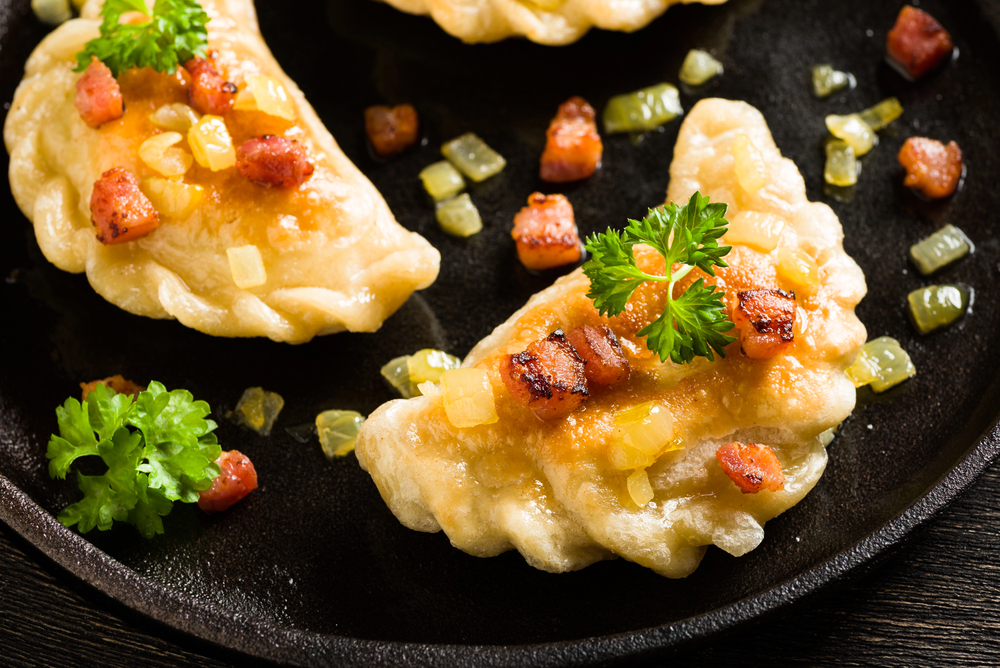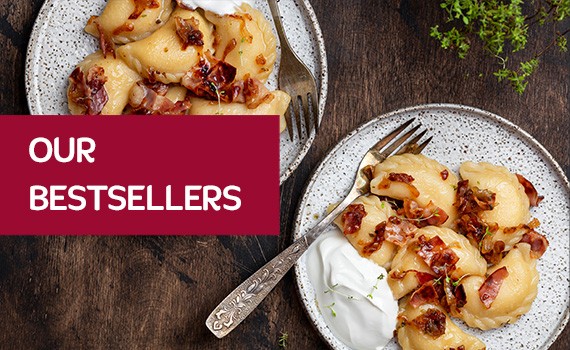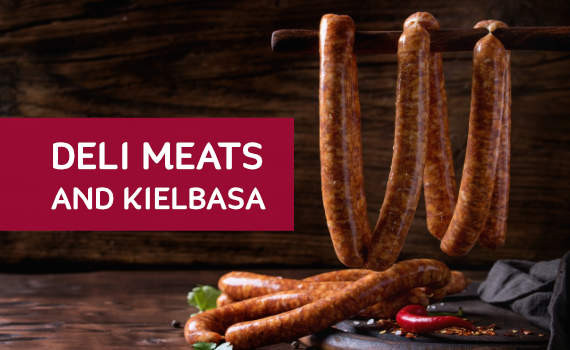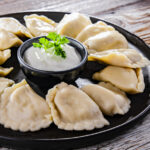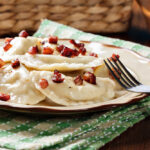In Poland, food is more than just sustenance; it’s a celebration of heritage and togetherness. Few dishes embody this spirit quite like smoky kielbasa and pierogi. This iconic duo represents the heart of Polish cuisine, offering a comforting and flavorful experience that has been cherished for generations.
Introduction to Polish Cuisine
Polish cuisine is a rich and diverse reflection of the country’s history, culture, and geography. With its hearty dishes, bold flavors, and comforting ingredients, Polish food has gained popularity worldwide. At the heart of Polish cuisine lies a deep appreciation for traditional ingredients, such as pierogi, kielbasa, and bigos. These staples are often combined with fresh vegetables, fruits, and dairy products to create delicious and satisfying meals. In this article, we’ll delve into the world of Polish cuisine, exploring its history, key ingredients, and popular dishes, including the beloved pierogi and kielbasa.
What are Pierogi?
Pierogi are delightful, filled dumplings crafted from unleavened dough. The dough, simple yet essential, combines flour, eggs, water, and a pinch of salt. Its texture is wonderfully similar to that of potstickers or ravioli. Pierogi’s versatility shines through their fillings, which range from savory to sweet. Savory favorites include potato and cheese, sauerkraut combined with mushrooms, and hearty meat. For those with a sweet tooth, fillings such as fruit and farmer’s cheese provide a delicious alternative. To cook pierogies, you can boil them until they float and then pan-fry them for a crispy finish.
What is Kielbasa?
Kielbasa, simply put, is the Polish word for sausage. But it’s not just any sausage. This term covers a vast array of sausages. These include smoked, fresh, and even dried varieties. The versatility extends to the meats used, with options like pork, beef, turkey, lamb, chicken, or veal, each offering a unique flavor profile. The savory kielbasa, in particular, is known for its rich, comforting flavors that make it a key ingredient in dishes like Crockpot Pierogi Casserole.
A Journey Through History: The Cultural Significance of Kielbasa and Pierogi
Both kielbasa and pierogi hold a special place in Polish history and culture, woven into the fabric of daily life and celebrations.
Kielbasa: A Royal Tradition
Kielbasa’s story in Poland dates back to at least the 14th century. It became popular when the royal court prioritized hunting, primarily in autumn and winter, which provided a constant supply of smoked sausage for the entire year. Kielbasa became a central feature in traditional dishes, especially during festive seasons. Making kielbasa was, and often still is, a community activity, with recipes passed down through generations and varying by region.
Pierogi: A Saint’s Gift
Legend says that pierogi arrived in Poland in the 13th century. Saint Hyacinth, a Polish Dominican friar, supposedly introduced them. He brought the recipe from his missionary work in Kyiv. Pierogi quickly became associated with celebrations. Different varieties were created for each specific holiday. During harder times, pierogi fillings became a reflection of available resources, commonly including potatoes, groats, buckwheat, or locally grown fruit.
Exploring the Varieties: Types of Kielbasa
The world of kielbasa is incredibly diverse. Each type boasts its own unique flavor and texture. Here are some of the most beloved varieties:
- Kabanosy: A thin, air-dried sausage, distinctively flavored with caraway seed.
- Kiełbasa Krakowska: A thick, straight sausage, hot-smoked and seasoned generously with pepper and garlic.
- Kiełbasa Wiejska: Known as farmhouse or countryside sausage, it is often presented in a large, characteristic U-shape.
- Kiełbasa Myśliwska: A smoked and dried pork sausage, related to kabanosy but significantly thicker.
- Kiełbasa Biała: A white sausage, typically sold uncooked and a frequent addition to hearty soups.
- Smoky Kielbasa: A type of kielbasa with rich, smoky flavors that add a savory, comforting note to dishes like pierogi casseroles.
A World of Flavors: Types of Pierogi
Pierogi offer an equally impressive range of flavors. There is a pierogi for every palate. Some popular choices include:
- Potato and Cheese: An enduring classic, these pierogi feature a creamy filling of mashed potatoes and cheese.
- Sauerkraut and Mushrooms: A very popular filling, especially favored during the Christmas season.
- Meat: Filled with savory ground meat, usually seasoned simply with salt and pepper.
- Spinach: A nutritious option, frequently combined with creamy feta cheese.
- Fruit: Sweet pierogi, filled with fruits such as blueberries, strawberries, or plums, offer a delightful dessert or sweet treat.
- Cheddar Pierogies: A popular variety featuring cheddar pierogies, combined with creamy chicken broth and savory kielbasa, creating a tempting and hearty dish.
Cooking Methods: Bringing Out the Best in Kielbasa and Pierogi
Both kielbasa and pierogi are adaptable to various cooking methods, each offering a slightly different culinary experience. To cook pierogies, you can start by boiling them until they float, then pan-fry them until they are golden brown for a comforting and flavorful dish.
Kielbasa: Versatile Cooking Options for Smoky Kielbasa
Kielbasa can be prepared in several ways: boiled, baked, grilled, or pan-fried. When grilling, it’s crucial to avoid cutting the kielbasa. Cutting it may cause it to leak juices. Pan-frying kielbasa with oil and sliced onions is a popular and simple method.
Pierogi: From Boiling to Frying Frozen Pierogies
Traditionally, pierogi are boiled. However, they can also be pan-fried, baked, grilled, or even deep-fried. When boiling frozen pierogi, cook them until they rise to the surface. Pan-frying after boiling is highly recommended; it creates an incredibly pleasing, crispy texture.
To cook pierogies, boil them until they float, then pan-fry for a crispy finish. You can easily buy pierogi online and enjoy the authentic flavors.
Recipe Inspirations: Delicious Kielbasa and Pierogi Dishes
Here are some popular recipes that showcase the delicious combination of kielbasa and pierogi:
Classic Pierogies with Kielbasa
Ingredients:
- 1 pound savory kielbasa, sliced
- 1 medium onion, sliced
- 2 tablespoons butter
- 1 box of pierogies (your favorite variety)
Directions:
- In a 12-inch skillet over medium heat, cook the onion in butter until tender. Stir occasionally.
- Add pierogies and savory kielbasa. Sauté pierogies for 4 to 6 minutes per side. Turn occasionally, until golden brown and the savory kielbasa is heated through.
Pierogi and Kielbasa Sheet Pan Dinner
Ingredients:
- 1/2 medium head green cabbage, cored and sliced thin
- 1 medium yellow onion, sliced thin
- 1/2 cup olive oil, divided
- 1 1/2 tsp kosher salt, divided
- 1 tsp ground black pepper, divided
- 1 lb frozen pierogies
- 1 lb kielbasa, sliced 1/2-inch thick
- 2 Tbsp red wine vinegar
- 2 Tbsp stone-ground Dijon mustard
- 2 tsp honey
- 1 clove garlic, finely chopped
- 2 Tbsp chopped fresh dill or parsley
- Sour cream, for serving
Directions:
- Preheat oven to 400°F. Line a half sheet pan with foil.
- In a medium bowl, toss cabbage, onion, 2 tablespoons oil, ¾ teaspoon salt, and ½ teaspoon pepper. Combine well. Place on the baking sheet.
- In the same bowl, toss frozen pierogi with 2 tablespoons oil, ½ teaspoon salt, and ¼ teaspoon pepper. Ensure pierogi are coated. Arrange on the sheet with the sliced kielbasa.
- Bake for 20 minutes. Stir the cabbage and flip the pierogi. Bake until the cabbage is golden and the kielbasa and pierogi are crispy, 20 to 30 minutes more.
- Meanwhile, in a bowl, whisk together vinegar, mustard, honey, garlic, remaining ¼ teaspoon salt, pepper, and herbs. Drizzle over the cooked ingredients. Serve with sour cream.
Crockpot Pierogi Casserole with Kielbasa
Ingredients:
- Three packages of cheddar pierogies
- Four cups of creamy chicken broth
- One 8-ounce block of cream cheese
- One cup of shredded cheddar cheese
- One pound of kielbasa, sliced
- Salt and pepper to taste
Directions:
- In a 4-6 quart crockpot, add three cups of creamy chicken broth, frozen pierogies featuring cheddar pierogies, sliced kielbasa, and cheddar cheese. Distribute evenly.
- Set crockpot to cook on high for 3-4 hours, or on low for 6 hours.
- 30 minutes before cooking ends, warm cream cheese with remaining creamy chicken broth. Microwave or use stovetop. Whisk until smooth.
- Pour cream cheese mixture into crockpot. Stir well. Sprinkle remaining cheddar cheese on top. Cover and cook on low for 30 more minutes. Let cheese melt, creating a creamy sauce.
- Serve the casserole hot. Garnish it with sliced green onions is perfect.
Sauces and Toppings: Enhancing the Flavor
The right sauces and toppings can elevate the flavors of kielbasa and pierogi to new heights. A creamy sauce is a popular topping for pierogi, adding a comforting and rich flavor that enhances the overall dish.
Kielbasa: Perfect Pairings
Here are some popular sauce choices for kielbasa:
- Mustard: A timeless classic, particularly Dijon mustard, complements kielbasa beautifully.
- Honey Mustard: This option provides a delightful balance of sweet and savory, enhancing the kielbasa’s smokiness.
- Barbecue Sauce: Offers a range of flavors, from smoky to sweet and tangy, providing versatility.
Pierogi: Delicious Enhancements
Consider these popular sauces and toppings for pierogi:
- Sour Cream: A classic Eastern European staple, especially delicious with potato and cheese fillings.
- Butter and Onion: Adds a simple yet savory dimension, particularly well-suited to meat-filled pierogi.
- Bacon and Onions: A traditional and flavorful topping for savory pierogi.
- Mushroom Sauce: A creamy and rich sauce that perfectly complements savory varieties.
- Creamy Sauce: A popular topping that enhances the flavor profile, making the dish heartwarming and satisfying for busy weeknights and family gatherings.
Nutritional Considerations
While undeniably delicious, it’s good to be mindful of the nutritional aspects of kielbasa and pierogi.
Kielbasa: Protein and Iron
Kielbasa provides a good source of protein and iron. However, it’s also important to note that it can be relatively high in fat and sodium.
Pierogi: Carbohydrates and Fiber
Pierogi are a source of carbohydrates and protein. Depending on the filling, they can also provide a good amount of fiber.
Serving Suggestions: Creating a Complete Polish Meal
Kielbasa and pierogi can be the stars of a main course or serve as delightful side dishes. They are frequently served alongside sauerkraut, creamy mashed potatoes, or a refreshing green salad. For a complete three-course Eastern European culinary experience, consider starting with a flavorful borscht and concluding with a traditional rustic plum cheesecake.
Serving and Storage: Practical Tips for Enjoying and Preserving Your Dishes
To fully enjoy your Polish dishes, it’s essential to know how to serve and store them properly. Here are some practical tips to help you make the most of your culinary creations:
- Serve pierogi hot, topped with melted cheddar cheese, sour cream, or fried onions.
- Store leftover pierogi in an airtight container in the refrigerator for up to three days or freeze for up to two months.
- When reheating pierogi, add a little water or broth to prevent drying out.
- Slice kielbasa thinly and serve with a side of rye bread, mustard, or pickles.
- Store kielbasa in the refrigerator for up to two weeks or freeze for up to six months.
Exploring Polish Cuisine: Beyond Kielbasa and Pierogi
While kielbasa and pierogi are undoubtedly two of Poland’s most famous dishes, there’s more to Polish cuisine than these staples. Here are some other delicious and traditional Polish dishes to try:
- Bigos: A hearty stew made with meat, sauerkraut, and beans, often referred to as “hunter’s stew.”
- Gołąbki: Stuffed cabbage rolls filled with ground meat and rice, simmered in a savory tomato sauce.
- Żurek: A sour rye soup made with meat, vegetables, and eggs, offering a unique tangy flavor.
- Pączki: Deep-fried doughnuts filled with jam or cream, a sweet treat especially popular during Carnival season.
- Makowiec: A poppy seed cake made with ground poppy seeds, honey, and various nuts, perfect for festive occasions.
These dishes showcase the diversity and richness of Polish cuisine, with its emphasis on local ingredients, traditional cooking methods, and bold flavors. Whether you’re a foodie, a history buff, or simply looking to explore new culinary horizons, Polish cuisine has something to offer everyone.
Conclusion: A Timeless Culinary Delight
Kielbasa and pierogi offer a versatile and delicious combination, suitable for both simple weeknight meals and special celebratory occasions. Their rich history, diverse flavors, and adaptability make them a truly beloved part of Polish cuisine. So, whether you’re a seasoned Polish food enthusiast or new to these culinary treasures, kielbasa and pierogi are sure to bring joy to your table.

